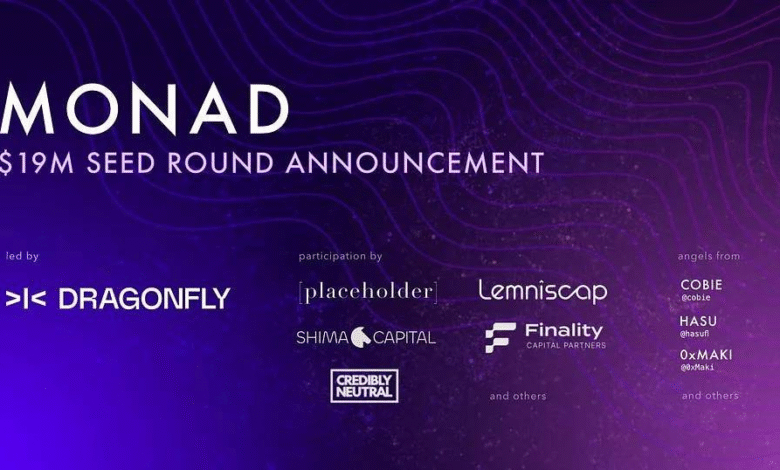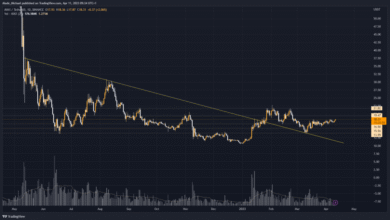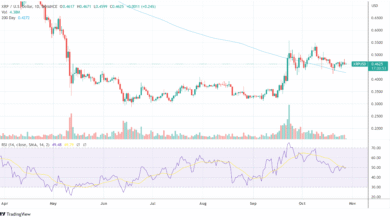Monad Blockchain: A Game-Changer for Ethereum Compatibility

The Monad blockchain is rapidly gaining attention as a pioneering Layer-1 blockchain designed to address the long-standing challenges of blockchain scaling. Unlike Ethereum, which relies on a modular architecture and offloads transactions to Layer-2 networks, Monad introduces a novel approach by utilizing parallel execution capabilities, promising Ethereum compatibility at unprecedented speeds. This makes Monad not just another entrant but a formidable contender among Solana alternatives, aiming to support thousands of transactions per second. As developers flock to explore this new technology, its unique infrastructure could transform how decentralized applications function on the blockchain. With plans to launch in early 2024, Monad’s ambitious project could redefine the landscape of smart contracts and solve pressing scalability issues in the crypto world.
The emergence of Monad’s blockchain presents a groundbreaking opportunity in the world of decentralized technology. As a Layer-1 solution, it aims to eliminate bottlenecks faced by previous generations of blockchains by implementing advanced techniques like parallel transaction execution. This innovative approach not only enhances speed but also maintains seamless compatibility with Ethereum applications, setting it apart from conventional platforms. As the quest for efficient blockchain scaling continues, Monad positions itself as a promising option among others, boasting capabilities that rival established networks like Solana and Aptos. The anticipation builds as we await Monad’s official launch in early 2024, which could drastically alter the competitive dynamics within the blockchain ecosystem.
Understanding Monad Blockchain’s Innovative Approach
Monad blockchain introduces a revolutionary concept in the realm of Layer-1 solutions by leveraging parallel execution to enhance transaction processing. This innovative mechanism addresses one of the most pressing challenges in blockchain scaling, particularly for Ethereum compatibility. Unlike traditional blockchains that handle transactions sequentially, Monad’s architecture allows multiple transactions to be processed simultaneously, thereby increasing throughput dramatically. This positions Monad not just as an Ethereum alternative, but as a direct competitor poised to tackle scalability effectively.
Designed with the developer in mind, Monad blockchain facilitates seamless integration of Ethereum applications such as Uniswap and Metamask without significant modifications. This compatibility ensures that existing Ethereum developers can transition to Monad with minimal friction while benefiting from enhanced performance and lower latency. By harnessing the powers of parallel execution and maintaining EVM compatibility, Monad stands to attract a large user base that seeks the benefits of both speed and familiarity in their blockchain experience.
The Promise of Parallel Execution for Blockchain Scaling
Parallel execution could be the transformative technology that the blockchain industry has been searching for, similar to the introduction of multi-core processors in computing. By adopting pipelining techniques, Monad blockchain aims to break away from the limitations that have plagued previous Layer-1 solutions. This approach not only promises an increase in transaction speed but also positions Monad as a viable platform for developers facing the limitations of blockchain scaling present in networks like Ethereum and Solana.
Moreover, with the rapid rise of decentralized finance (DeFi) applications, the demand for scalable solutions has never been more critical. The enhanced performance capabilities of Monad, driven by its parallel execution mechanism, may help it emerge as one of the leading platforms in the next blockchain era. It also allows Monad to potentially consume a share of the DeFi market currently dominated by Ethereum, which has struggled with congestion and high gas fees.
Comparative Analysis: Monad vs. Ethereum and Solana
When comparing Monad blockchain, Ethereum, and Solana, it’s essential to explore their varying approaches to scaling. Ethereum has embraced a modular architecture that offloads some tasks to Layer-2 solutions, while Solana’s singular focus on parallel transaction processing allows it to achieve extraordinary speeds. Monad aims to harness the benefits of both, by providing an Ethereum-compatible network that excels in speed and transaction capacity. This hybrid approach may attract developers and users that seek the performance of Solana, yet want the robust application ecosystem embedded within Ethereum.
With its unique technology, Monad has the potential to position itself as a viable alternative to both Ethereum and Solana. The ability to execute transactions simultaneously could redefine user and developer experiences, especially for those who are frustrated with Ethereum’s current limitations. If Monad successfully capitalizes on its strengths in performance while offering a familiar environment for Ethereum developers, it might just claim a significant market share in the evolving blockchain landscape.
The Role of Monad in Augmenting Ethereum’s Ecosystem
Contrary to the prevailing narrative that new blockchain projects such as Monad threaten Ethereum’s existence, it is imperative to acknowledge how Monad can actually complement Ethereum’s ecosystem. By providing a high-speed platform that is EVM compatible, Monad allows Ethereum developers to build and scale applications without needing to adapt to a new programming environment or architecture. This collaboration could foster a healthy synergy, enhancing the overall blockchain landscape rather than creating divisions.
Founder Keon Hon has expressed that the vision behind Monad is to contribute positively to blockchain scaling as a whole, emphasizing that more options can ultimately lead to a better experience for Ethereum users. By facilitating the rapid adoption of decentralized applications (dApps) and increasing the throughput capacity of Ethereum-based innovations, Monad positions itself as a crucial player in the future of blockchain technology.
Launching into the Future: Monad’s Upcoming Test Network
With the launch of Monad’s test network on the horizon, excitement is building within the blockchain community. This early access will enable developers to explore the capabilities of Monad blockchain and provide valuable feedback ahead of its mainnet launch expected in early 2024. Such preparatory steps are critical in ensuring the technology operates as intended and meets the needs of developers looking for Ethereum-compatible solutions that maximize performance.
Though optimism surrounds Monad’s unique approach, skepticism often shadows new blockchain initiatives. The true test will lie in how effectively Monad can execute its plans and whether it can successfully attract users and developers from established networks like Ethereum and Solana. As the project unfolds, keeping an eye on its developments will provide insights into the future capabilities of Layer-1 blockchains.
Monad’s Financial Backing and Market Prospects
Starting with an initial capital of $19 million, Monad has set out with a strategic vision to challenge its more established competitors in the industry. This funding demonstrates confidence from investors in its innovative approach to solving blockchain scaling issues. Such financial backing is crucial for new blockchain projects, as it allows them to focus on development and marketing efforts that could accelerate user adoption.
In a rapidly evolving market landscape, the performance of Monad will correlate with its ability to differentiate itself from alternatives like Solana and Ethereum through sustained value creation. The momentum garnered from launch activities and subsequent user engagement could set the stage for Monad to become a strong contender in the blockchain ecosystem, appealing to both developers and users seeking high-performance blockchain solutions.
Exploring the Ecosystem: How Monad Facilitates DeFi Innovations
Monad’s architecture holds great promise for the DeFi sector, where speed and efficiency are paramount for user experience and trust. By enabling rapid transaction completion through parallel execution, Monad can facilitate a higher frequency of trades and interactions, proving beneficial for decentralized exchanges and lending protocols. With Ethereum struggling with scalability, the timing is ripe for a solution like Monad to capture the interest of project developers and users.
Furthermore, the transition of existing Ethereum dApps to Monad is designed to be smooth, potentially inviting many projects to consider switching or launching new iterations on this platform. The goal here is not just to replicate Ethereum services but to evolve and enhance them using Monad’s advanced blockchain technologies, thus driving further adoption within the DeFi space.
The Need for Speed: Why Cryptocurrency Users Demand Performance
As the blockchain landscape continues to grow and evolve, users increasingly prioritize speed and transaction efficiency. Cryptocurrency transactions that can take minutes or longer to finalize can significantly hinder day-to-day use cases, including trading and payments. Monad’s commitment to enhancing speed through advanced transaction processing capabilities positions it as a desirable option for users frustrated with slower networks, solidifying its market relevance.
In addition to enabling faster transactions, Monad’s innovative features also address broader concerns around user experience and accessibility within the crypto realm. With functionalities that mirror Ethereum’s existing ecosystem, users can expect a familiar environment that enhances their overall engagement with the blockchain while benefiting from the high-speed capabilities that Monad promises.
Future Challenges: Can Monad Achieve its Promises?
As Monad embarks on its ambitious journey, the fundamental question remains whether it can deliver on the groundbreaking promises it makes. The crypto space is rife with projects that have failed to live up to grand expectations, and Monad must navigate these challenges with careful execution and community engagement. Building trust within the ecosystem will be vital for its success, as developers and users alike seek a dependable platform that can sustain high performance.
Moreover, fast adoption hinges not just on technical prowess but also on the ability to maintain decentralization, a principle integral to the blockchain philosophy. Swift execution, community-driven governance, and sound economic models will be instrumental in securing Monad’s place in the blockchain landscape, guiding it towards becoming a competitive layer against industry giants while fostering overall innovation.
Frequently Asked Questions
What is Monad blockchain and how does it achieve Ethereum compatibility?
Monad blockchain is a high-performance, Layer-1 blockchain that integrates Ethereum compatibility through its unique architecture that allows for parallel execution of transactions. This means that Ethereum applications can be easily ported to Monad without significant changes for users, creating an efficient alternative in the blockchain ecosystem.
How does Monad blockchain utilize parallel execution for better blockchain scaling?
Monad blockchain employs parallel execution, a feature that enables it to process multiple transactions simultaneously, which significantly improves its scalability. This method is crucial for handling larger volumes of transactions, similar to the advancements made by next-generation blockchains like Solana, which allows for thousands of transactions per second.
How does Monad compare to other Layer-1 blockchains like Solana in terms of performance?
Monad aims to challenge established Layer-1 blockchains like Solana by offering not only Ethereum compatibility but also superior processing speeds through its advanced transaction execution techniques. Monad plans to achieve similar transaction rates as Solana while maintaining the usability of Ethereum’s ecosystem.
Can developers easily transition their Ethereum projects to Monad blockchain?
Yes, developers can seamlessly transition Ethereum-based projects to Monad blockchain due to its EVM compatibility. This allows applications like Uniswap and Metamask to operate on Monad as if they were still on Ethereum, ensuring a smooth development experience without the need for extensive modifications.
What are the potential benefits of Monad’s ‘superscalar pipelining’ technology?
Monad’s ‘superscalar pipelining’ technology enhances task execution efficiency, leading to faster transaction processing and shorter block times. This innovation promises to offer significant speed advantages over traditional sequential processing found in other blockchains, contributing to better overall performance.
Is Monad blockchain a scaling solution for Ethereum?
No, Monad blockchain is not a scaling solution for Ethereum; it is an independent Layer-1 blockchain with its own consensus and validators. While it offers compatibility with Ethereum applications, Monad operates separately and aims to enhance blockchain scaling on its own terms.
What does the future hold for Monad in the blockchain ecosystem?
Monad’s success depends on its ability to launch its technology effectively, with testing scheduled for late 2023 and a mainnet launch anticipated in early 2024. If successful, it could become a strong competitor to Ethereum and other blockchains by providing improved scalability and performance.
How does Monad plan to contribute to the broader Ethereum ecosystem?
Monad aims to enhance blockchain scaling collectively rather than just compete with existing networks. Its advancements in parallel execution and pipelining could make a positive impact on the Ethereum ecosystem by providing more efficient alternatives that benefit users and developers alike.
| Feature | Ethereum | Solana | Monad |
|---|---|---|---|
| Architecture | Modular architecture with Layer-2 networks | Single chain with parallel transaction execution | Layer-1 blockchain with parallel execution and EVM compatibility |
| Transaction Speed | Lower peak throughput | Thousands of transactions per second | Aiming to be as fast as Solana with advanced technology |
| Compatibility | EVM compatibility with limitations | Not specifically EVM compatible | Seamless integration of Ethereum applications and developers |
| Innovative Features | Sequential execution of transactions | Parallel execution on a single chain | Superscalar pipelining for efficiency and speed |
Summary
Monad blockchain is entering the crypto space with the ambitious goal of providing a high-performance alternative to Ethereum and other blockchains. Its unique architecture promises parallel transaction execution while maintaining Ethereum compatibility, a factor that could significantly enhance its appeal to developers and users alike. As it aims to launch its test network soon, the potential for Monad to redefine blockchain scalability awaits to be seen.



